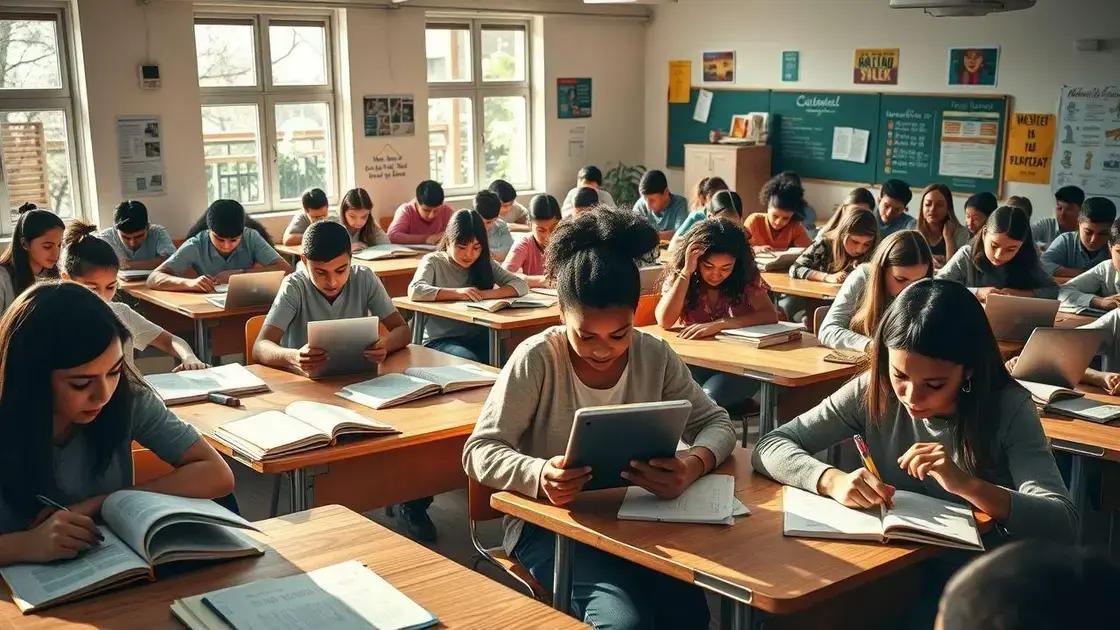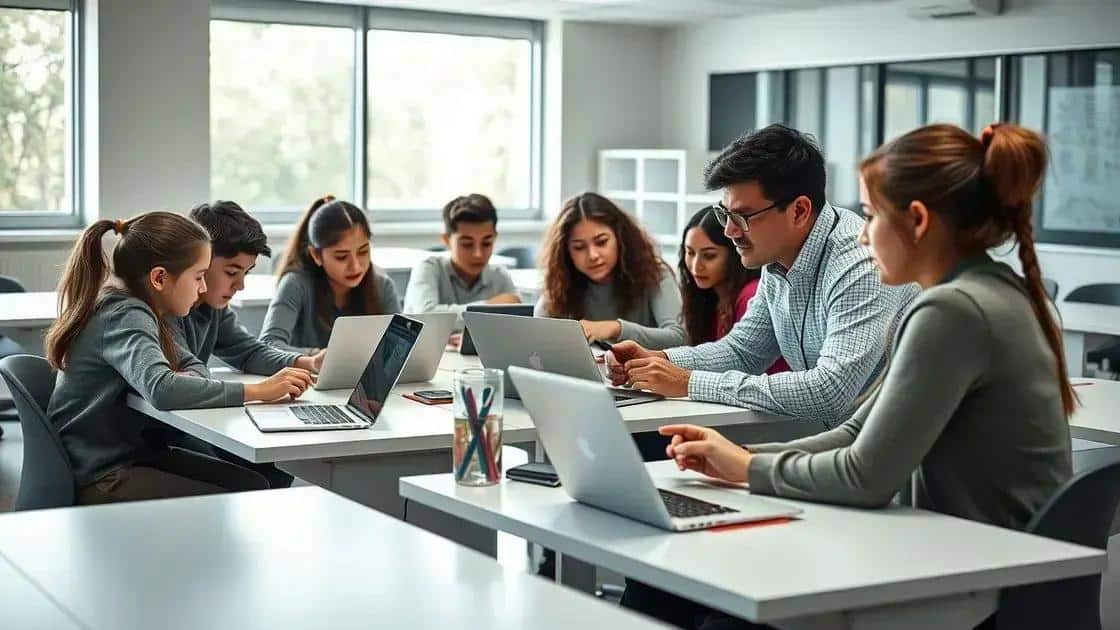Throughout textbook policy updates, discover key changes

The future of educational resources involves integrating advanced technologies and open educational resources to create engaging, inclusive, and accessible learning experiences for all students.
Throughout textbook policy updates, educators face a dynamic landscape that shapes how they teach. Have you ever wondered how these changes may influence your classroom? Let’s dive in.
Understanding textbook policy changes
Understanding textbook policy changes is crucial for educators and students alike. These changes can alter the way content is delivered and what materials are available. Keeping updated on these policies can help you better navigate the educational landscape.
Why are textbook policies changing?
Changes in policies are driven by technology, educational standards, and the needs of students. As digital resources gain popularity, schools are adapting. They aim to provide the best educational tools available.
Key components of textbook policy changes
- Digital resources: Increased use of e-books and online materials.
- Affordability: Efforts to reduce costs for students through open educational resources.
- Curriculum alignment: Ensuring materials meet current educational standards.
- Sustainability: Adopting environmentally friendly publishing practices.
These components are not just buzzwords; they represent real shifts in how education is perceived and delivered. For example, many schools now offer more flexible learning options that integrate technology seamlessly.
The focus on affordability means that many schools are exploring new ways to provide materials. This could involve using online platforms that offer free or lower-cost options. As you consider these changes, it’s essential to evaluate how they can benefit your teaching practice.
Impact on students and educators
Changes in textbook policies have significant implications. For students, access to a wider range of learning materials means more personalized learning experiences. For teachers, it opens up new methods for lesson planning and engagement.
Moreover, having access to diverse resources can help create a more inclusive classroom. Recognizing different learning styles is vital in today’s educational environment. Educators must adapt to these changes to stay relevant.
Key updates in education policy
Key updates in education policy affect how schools operate and what resources are available for students and teachers. These changes are critical for adapting to new educational challenges and ensuring quality education for all.
Recent legislative changes
Governments are continually reviewing and updating education policies. Recent changes include enhanced funding for schools, which aims to improve resources and technology access. These updates can lead to substantial improvements in classroom environments.
- Increased funding: More financial support for underfunded schools.
- Technology integration: Emphasis on incorporating technology in classrooms.
- Curriculum enhancements: Updates to align educational materials with modern standards.
- Special education support: Improved services for students with disabilities.
Such changes can have a profound impact on student engagement and success. For instance, more funding can lead to smaller class sizes, which often results in better individualized attention from teachers.
Focus on equity and inclusion
Another critical aspect of recent education policy updates is a focus on equity and inclusion. Policymakers prioritize ensuring that all students, regardless of background, have access to the same quality of education. This shift is essential for closing achievement gaps.
A commitment to diversity and inclusion means that schools are adopting practices that support all learners. This includes cultural competency training for educators and updated teaching methods that address varied learning styles.
Having diverse educational materials can also help reflect the experiences of different student populations. By incorporating a broader range of perspectives, schools can create an enriching environment that values every student.
Impact of updates on classroom practices

The impact of updates on classroom practices can greatly reshape how education is delivered. These changes influence teaching methods, student interaction, and overall classroom dynamics.
Adapting to new technologies
One significant impact comes from the integration of new technologies. Educators are increasingly using digital tools to enhance learning experiences. This transition improves engagement and fosters collaboration among students.
- Interactive learning: Tools like smartboards and tablets create more engaging lessons.
- Remote learning options: Updates allow for flexible learning beyond traditional classroom walls.
- Access to resources: Online platforms provide a wealth of information and learning materials.
- Real-time feedback: Digital assessments offer immediate insight into student performance.
As classrooms adopt these technologies, teaching practices evolve. For instance, flipped classrooms allow students to learn at their own pace at home, freeing up class time for discussions and hands-on activities.
Changing roles of teachers
With these updates, the role of teachers is also changing. They are no longer just providers of information but facilitators of learning. This shift encourages educators to focus on mentoring and guiding students in their educational journeys.
Teachers engage with students more effectively through personalized instruction. They can tailor lessons to meet individual learning needs, helping every student succeed. Additionally, professional development programs help educators stay informed about the latest teaching strategies and tools.
Supporting collaboration among students is crucial in today’s classroom. Group work and peer tutoring foster a sense of community and encourage critical thinking skills. With updates in place, teachers can create an environment where all students feel empowered to participate.
Navigating new textbook policies
Navigating new textbook policies is essential for educators as these guidelines shape curriculum choices and teaching approaches. Understanding these policies can help teachers make informed decisions that benefit their students.
Understanding textbook adoption processes
The textbook adoption process can vary by state and district. Generally, educators review materials to find the best fit for their classrooms. This can include analyzing textbooks for content accuracy, relevance, and alignment with educational standards.
- Researching materials: Teachers often gather information on available textbooks from publishers.
- Review committees: Many schools form committees to evaluate and recommend books.
- Stakeholder input: Gathering feedback from parents and students can enhance the selection process.
- Trial periods: Allowing students to use books before final decisions can ensure quality.
By understanding how these processes work, teachers can play a more active role in choosing resources that meet their students’ needs. This involvement ensures that the materials are not only educationally sound but also engaging for learners.
Staying updated with policy changes
New policies can emerge, requiring teachers to adapt quickly. Staying informed about changes in textbook policies is crucial. Subscribe to educational newsletters or join professional organizations that provide updates on policy shifts.
Engaging with fellow educators can also offer insights into how to navigate changes effectively. Collaboration fosters a sense of community and can make adapting to new policies smoother.
Additionally, participating in workshops can help educators understand implications of changes and how to implement them in classrooms. This proactive approach allows teachers to remain confident and prepared in the face of evolving requirements.
Future outlook for educational resources
The future outlook for educational resources is evolving rapidly. With advances in technology and changing educational needs, schools are rethinking how materials are used in classrooms. This evolution is important for enhancing student learning.
Emerging technologies
One of the most exciting aspects of the future is the integration of emerging technologies. Tools such as virtual reality (VR) and augmented reality (AR) offer immersive experiences for students. These technologies can bring subjects to life in ways traditional textbooks cannot.
- Virtual field trips: Students can explore historical sites or distant planets without leaving the classroom.
- Interactive simulations: Science lessons can become lab experiences through realistic simulations.
- Gamification: Applying game design elements can make learning more engaging.
- Global connectivity: Students can connect with peers worldwide for collaborative projects.
These tools not only enhance student interest but also improve understanding of complex subjects. As educators utilize these technologies, they will need to consider how best to integrate them into their curricula.
Shift towards open educational resources
Another significant trend is the shift towards open educational resources (OER). OER provides free, accessible learning materials that can be adapted for different educational settings. This shift can democratize education, allowing every student access to high-quality resources regardless of their socioeconomic status.
Additionally, OER enables teachers to customize content to fit the needs of their classes. This flexibility can help address diverse learning styles and paces, ensuring that all students have the necessary support to succeed.
As education continues to change, the focus will be on creating engaging, inclusive resources that cater to the needs of all learners. The collaboration between educators, technology developers, and policymakers will be crucial in shaping the landscape of education for the future.
FAQ – Questions about the Future of Educational Resources
What role does technology play in modern education?
Technology enhances learning by providing interactive tools and resources, making lessons more engaging for students.
How can open educational resources benefit students?
Open educational resources provide free access to high-quality materials, ensuring all students can learn effectively regardless of their background.
What is gamification in education?
Gamification involves using game-like elements in learning to increase student motivation and engagement.
Why is collaboration important for educational resource development?
Collaboration among educators, policymakers, and tech developers ensures that resources meet diverse learning needs and remain relevant.






